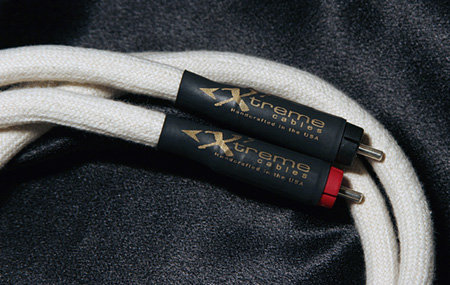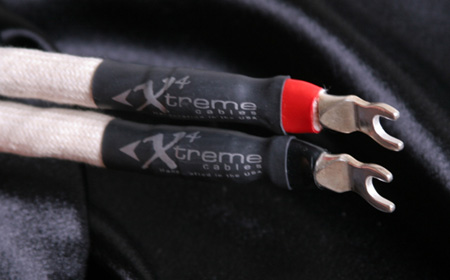You are reading the older HTML site
Positive Feedback ISSUE
18
march/april 2005
xtreme cables
2, 4, and 5 interconnects
as reviewed by Ed Morawski

|
ED MORAWSKI'S SYSTEM:
LOUDSPEAKERS
ELECTRONICS
SOURCES
CABLES
ACCESSORIES
|
Many audiophiles seem to follow a similar progress in their attitude about cables. Like many of you, I went through this. At first, I thought of cables as the things that connected my components together. After a while, I was goaded into buying some better ones out of self-respect. I didn't want to be laughed at by other audiophiles, but I also didn't want to be laughed at by my other friends. I still didn't believe cables sounded different, but I also didn't want to spend much money.
I have been involved in electronics since I was a teenager—a long, long time ago. I enlisted in the Air Force and worked as a technician for eight years, then worked in electronics for several large security firms. I've worked on some very complex security systems, and can tell you something I learned quickly: Better wire will not necessarily make an improvement, but the wrong wire will cause disaster. For example, if you use shielded wire in certain kinds of data communication circuits, the shield will clamp down the data and render it unusable at the other end. It is also a mistake to use parallel multi-conductor wire when it should be twisted. I think that this proves that wire does indeed make a difference.
Therefore, the concept of exotic audio cables, which initially seems a little out there for most people, was not completely foreign to me. As my systems got better, I had to wonder whether there might be something to this whole thing, and whether more expensive cables would make my system sound better. This brings me to Brian Kyle of Xtreme Cables. I met Brian when I purchased some equipment from him, and he casually mentioned that he was about to launch a new cable company. "Would I like to hear some samples?" A better question might have been, "Would I like to have a tooth pulled?" but out of politeness I agreed and sat down to listen.
Xtreme Cables' claim to fame was more unusual than most, and more than I was ready for. Brian insisted that plastic and other hard materials in the cable jacket affected the sound, so he used special mixtures of conductors covered by pure, un-dyed cotton jackets! "Okay, now I really have heard it all," I thought, but I had to admit that he was onto something. His system sounded very open and pure. Brian switched various cables in and out—his and others—and I could definitely hear differences.
I asked Brian to keep me informed and went on my way. Almost a year passed and I nearly forgot about Xtreme, thinking once or twice that he couldn't make a go of it. Then, a few months ago, Brian called me and asked if I was still interested in his cables. Apparently he had gone through numerous conductor materials, but the cotton jackets were still his centerpiece. Suddenly I had several sets of Xtreme cables to audition, including power cords, speaker cables, and three varieties of interconnect. Xtreme 2 is the beginner-level interconnect, then there is Xtreme 4, which I believe has more silver content, and finally (for now), Xtreme 5, which is a very interesting hybrid of silver and gold. It is complicated enough to review just one kind of cable, so I concentrated on the interconnects, but will begin by briefly offering my observations on the other cables. For the auditions, I used both the combination of my bridged Bel Canto eVo2 amps and E.A.R. 864 preamp and my DK Design Group VS-1 Mark II integrated amp. The sources were my Musical Fidelity Nu Vista CD player or a Roku Soundbridge with a Musical Fidelity Tri-Vista 21 DAC. Speakers were my own DIY pair, Usher X-719s, or Von Schwiekert VR-1s.

The Xtreme power cords are very quiet and very open. I could easily live with them as a reference. The speaker cables are also very open and transparent. Each time I inserted these cables it was a revelation. They were noticeably more detailed than my reference cables, yet they were airy and unrestrained. The music opened up and flooded the room in a way it had never done before. I will probably make these my reference speaker cables as soon as I can get a new pair from Xtreme, as they are in very short supply right now.
Now for the interconnects. All of them use Eichmann bullet connectors, and the cables are very pliable and easy to install. Despite appearing somewhat delicate, they are quite sturdy. I removed and installed each set several times without any problems whatsoever. The Xtreme 2s, like the other Xtreme cables I had tried, sounded open. They were clean, detailed, and transparent without being bright or brittle. Their imaging and soundstaging was quite good, as were the bass and midrange. They sounded very similar to my reference Empirical Audio Holophonic interconnects, and were not better.
As soon as I installed the Xtreme 4s, I heard a noticeable increase in resolution and even more airy openness. They did tend toward the cool end of the spectrum, and on certain recordings I initially found them a little too cool. The Xtreme 5s are a silver-and-gold hybrid on which Brian has been working for quite a while. They hit a home run as soon as the first notes played. The detail, openness, and imaging of the less expensive Xtreme cables were still there, but a slight warmth joined in for some very pleasing musicality. The 5s were smooth and inviting, but lacked nothing that the other Xtreme cables brought to the table.
I left the Xtreme 5s installed, and played many different recordings over the next few weeks. From Madonna's American Life to Diana Krall's Live in Paris, there was nothing these cables didn't do very well. I enjoyed Tift Merritt's Bramble Rose for its twangy guitar and willowy vocals and Patricia Barber's Café Blue for its rich, vibrant textures. When I was preparing to finish this review, I took the Xtreme cables out, put my reference cables back in, and noted the differences. There was a slight collapse in imaging and soundstage as well as a noticeable decrease in resolution. I then put the Xreme 4s back in, and something else became immediately apparent. I had to turn the volume down! At this point I preferred the 4s, and had to again compare them to the 5s. It was almost too close to call.
The final test involved combinations of Xtreme cables. For this phase, I used my E.A.R. preamp and Bel Canto amps. First up were the Xtreme 5s, both from the Nu Vista CD player to the E.A.R. and from the E.A.R. to the eVo2s. This was a very satisfying setup, with warm, rich tones. Brian had always suggested that I mix the 4s and 5s, so I tried that combination. With the 5s remaining between the CD player and preamp, I inserted the 4s between the preamp and the amps. Once again, I had to turn the volume down considerably, but this combination proved magical. Brian was right—this was audiophile nirvana.
When I played Alison Krauss' New Favorites, instruments sprang out in three-dimensional relief as they never had before, but the most striking thing was the texture of her voice. This also proved true with The Corrs Unplugged. On track 14, "Everybody Hurts," Andrea Corrs' oh-so-sweet voice gave me chills. I couldn't tear myself away, and the 15-minute test lasted several hours. Madonna's American Life was the last CD I played before the cables had to go back to Brian. Most of the sibilance in her voice was smoothed out, but the bass was tremendously taunt and deep, and the soundstage suddenly extended about ten feet past my walls.
During the final weeks of this review, the Xreme 5s had been in place for some time and my system was stabilized, so I was able to judge the effects of Xtreme's Quicksilver Contact Enhancer. It takes anywhere from one day to several weeks to settle in, but I could now hear a significant improvement in the sound of my system. Aside from a noticeable increase in volume (I must have turned my volume down several times in the past weeks), the sound got clearer and more detailed, yet smoother and more musical. The biggest improvement, however, was in the imaging. The soundstage was more three-dimensional than ever. It was as if I could take a tape measure and precisely map the position of each performer on stage.
If your taste runs toward open, airy, transparent, and detailed sound, I can highly recommend the Xtreme cables (and the Quicksilver). Do the cotton jackets really make a difference? It's hard to say, but I love them because they are so flexible! I think Brian Kyle is onto something.
Finally we come to the price of these pieces of musical satisfaction (all prices are for one-meter pairs of single-ended Interconnects):
X2 MSRP: $825 (45% Off - Introductory Special Price: $453.75)
X4 MSRP: $875, (45% Off - Introductory Special Price: $481.25)
X5 MSRP: $1100, (45% Off - Introductory Special Price: $605.00)
While these prices are competitive for this level of performance, Xtreme Cables offers an extremely generous 45 percent introductory discount if you sign up for their newsletter, and if you purchase several sets of cables in the same order, they offer a 50 percent discount. To the best of my knowledge, this is a first. Ed Morawski
Xtreme AV
web address: www.xtremecables.com
